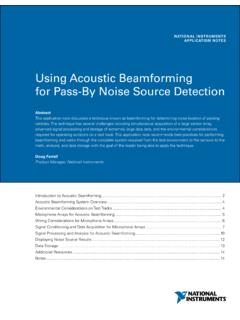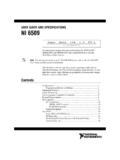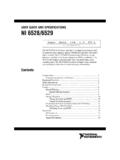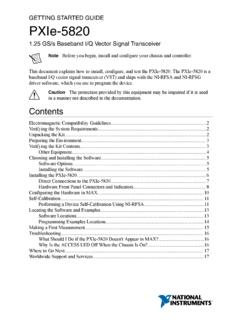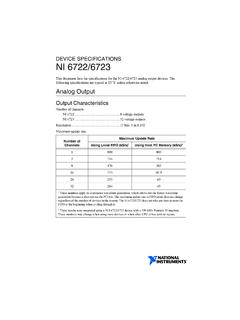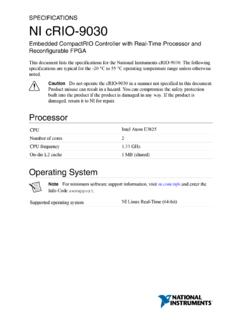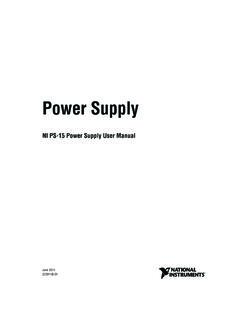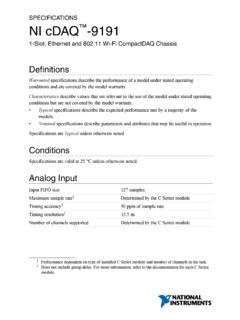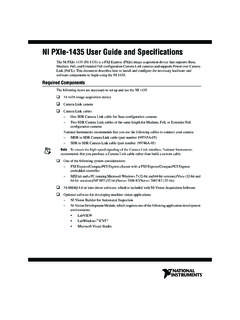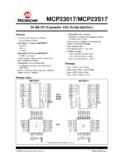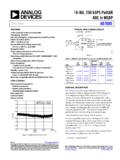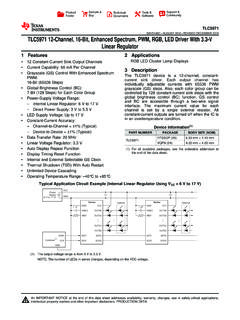Transcription of GETTING STARTED GUIDE to ±10 V, 16 Bit, 250 …
1 GETTING STARTED GUIDE . NI 9205. 16 AI Differential/32 AI Single-Ended, 200 mV. to 10 V, 16 Bit, 250 kS/s aggregate This document explains how to connect to the NI 9205. Note Before you begin, complete the software and hardware installation procedures in your chassis documentation. Note The guidelines in this document are specific to the NI 9205. The other components in the system might not meet the same safety ratings. Refer to the documentation for each component in the system to determine the safety and EMC ratings for the entire system.
2 Safety Guidelines Operate the NI 9205 only as described in this document. Caution Do not operate the NI 9205 in a manner not specified in this document. Product misuse can result in a hazard. You can compromise the safety protection built into the product if the product is damaged in any way. If the product is damaged, return it to NI for repair. 2 | | NI 9205 GETTING STARTED GUIDE Hazardous Voltage This icon denotes a warning advising you to take precautions to avoid electrical shock with the NI 9205 with spring terminal . Safety Voltages Connect only voltages that are within the following limits: Maximum voltage1.
3 Channel-to-COM 30 VDC. NI 9205 with Spring Terminal Isolation Voltages Channel-to-channel None Channel-to-earth ground2. Continuous 250 Vrms, Measurement Category II. Withstand 2,300 Vrms, verified by a 5 s dielectric withstand test 1 The maximum voltage that can be applied or output between AI and COM. without creating a safety hazard. 2 This specification is valid only up to 2,000 m. NI 9205 GETTING STARTED GUIDE | National Instruments | 3. Measurement Category II is for measurements performed on circuits directly connected to the electrical distribution system.
4 This category refers to local-level electrical distribution, such as that provided by a standard wall outlet, for example, 115 V for or 230 V for Europe. Caution Do not connect the NI 9205 to signals or use for measurements within Measurement Categories III. or IV. NI 9205 with DSUB Isolation Voltages Channel-to-channel None Channel-to-earth ground Continuous 60 VDC, Measurement Category I. Withstand up to 2,000 m 1,000 Vrms, verified by a 5 s dielectric withstand test up to 5,000 m 500 Vrms, verified by a 5 s dielectric withstand test 4 | | NI 9205 GETTING STARTED GUIDE Measurement Category I is for measurements performed on circuits not directly connected to the electrical distribution system referred to as MAINS voltage.
5 MAINS is a hazardous live electrical supply system that powers equipment. This category is for measurements of voltages from specially protected secondary circuits. Such voltage measurements include signal levels, special equipment, limited-energy parts of equipment, circuits powered by regulated low-voltage sources, and electronics. Caution Do not connect the NI 9205 to signals or use for measurements within Measurement Categories II, III, or IV. Safety Guidelines for Hazardous Voltages You can connect hazardous voltages only to the NI 9205 with spring terminal.
6 Do not connect hazardous voltages to the NI 9205 with DSUB. If hazardous voltages are connected to the device, take the following precautions. A hazardous voltage is a voltage greater than Vpk voltage or 60 VDC to earth ground. NI 9205 GETTING STARTED GUIDE | National Instruments | 5. Caution Ensure that hazardous voltage wiring is performed only by qualified personnel adhering to local electrical standards. Caution Do not mix hazardous voltage circuits and human-accessible circuits on the same module. Caution Ensure that devices and circuits connected to the module are properly insulated from human contact.
7 Caution When module terminals are hazardous voltage LIVE (> Vpk/60 VDC), you must ensure that devices and circuits connected to the module are properly insulated from human contact. You must use the NI 9940 connector backshell kit to ensure that the terminals are not accessible. Note You can use the NI 9940 only with the NI 9205. with spring terminal. Safety Guidelines for Hazardous Locations The NI 9205 is suitable for use in Class I, Division 2, Groups A, B, C, D, T4 hazardous locations; Class I, Zone 2, AEx nA IIC T4. and Ex nA IIC T4 hazardous locations; and nonhazardous 6 | | NI 9205 GETTING STARTED GUIDE locations only.
8 Follow these guidelines if you are installing the NI 9205 in a potentially explosive environment. Not following these guidelines may result in serious injury or death. Caution Do not disconnect I/O-side wires or connectors unless power has been switched off or the area is known to be nonhazardous. Caution Do not remove modules unless power has been switched off or the area is known to be nonhazardous. Caution Substitution of components may impair suitability for Class I, Division 2. Caution For Division 2 and Zone 2 applications, install the system in an enclosure rated to at least IP54.
9 As defined by IEC/EN 60079-15. Caution For Division 2 and Zone 2 applications, connected signals must be within the following limits. Capacitance F maximum NI 9205 GETTING STARTED GUIDE | National Instruments | 7. Special Conditions for Hazardous Locations Use in Europe and Internationally The NI 9205 has been evaluated as Ex nA IIC T4 Gc equipment under DEMKO Certificate No. 03 ATEX 0324020X and is IECEx UL certified. Each NI 9205 is marked II 3G. and is suitable for use in Zone 2 hazardous locations, in ambient temperatures of -40 C Ta 70 C.
10 If you are using the NI 9205. in Gas Group IIC hazardous locations, you must use the device in an NI chassis that has been evaluated as Ex nC IIC T4, Ex IIC. T4, Ex nA IIC T4, or Ex nL IIC T4 equipment. Caution You must make sure that transient disturbances do not exceed 140% of the rated voltage. Caution The system shall only be used in an area of not more than Pollution Degree 2, as defined in IEC 60664-1. Caution The system shall be mounted in an ATEX/IECEx-certified enclosure with a minimum ingress protection rating of at least IP54 as defined in IEC/EN 60079-15.
